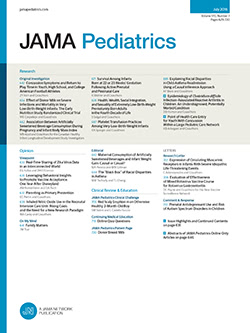Intensive Nurse Home Visiting and Early Childhood Outcomes: A Randomized Clinical Trial.
IF 18
1区 医学
Q1 PEDIATRICS
引用次数: 0
Abstract
Importance Programs that provide home visiting in early life have been proposed as a way to reduce early childhood adversity and improve child health outcomes. More evidence is needed to understand these programs' impact when delivered at scale. Objective To evaluate how receiving home visits through the Nurse-Family Partnership (NFP), a program designed to support young and low-income families, impacted children's utilization and health outcomes in the 2 years after birth. Design, Setting, and Participants The NFP is a home visiting program designed with the aim of reducing the incidence of adverse health outcomes in early childhood. In this study, we used data from a randomized clinical trial that enrolled 5670 Medicaid-eligible pregnant people in South Carolina who were randomly assigned at a 2:1 ratio to the NFP treatment (n = 3806) or usual care (n = 1864) between 2016 and 2020. The trial was conducted in 9 NFP-implementing authorities. Participants were eligible if they were fewer than 28 weeks pregnant with their first child, aged 15 years or older, and income eligible for Medicaid (income <200% of the federal poverty level). Data analysis was performed from June 2023 to July 2024. Intervention The treatment group was offered NFP home visits during pregnancy and 2 years postpartum, while the control group received usual care. Main Outcomes and Measures The primary outcome was a composite measure that included child mortality and claims related to major injury or concern for abuse or neglect within the first 2 years of life. Secondary outcomes included emergency department utilization and preventive health care measures, such as well-child visits and their components, including screenings for cognitive development, blood lead levels, fluoride varnish application, and dental health. We used an intent-to-treat approach with a linear regression model to estimate the treatment effect of NFP on early childhood outcomes by comparing participants assigned to the control and treatment group, regardless of whether they used NFP services. Results Among enrolled participants, 4932 individuals were tracked to a live birth (3295 in the intervention group and 1637 in the control group) and were analyzed for child health and utilization outcomes once their child turned 2 years old. Mean (SD) participant age was 22.5 (4.7) years. The incidence of the composite adverse outcome was 27.3% and 26.8% in the intervention and control groups, respectively (adjusted between-group difference, 0.4 percentage points; 95% CI, -2.3 to 3.0), with no statistically significant differences between elements of the composite primary outcome. Among participants assigned to receive NFP, their children were less likely to use the emergency department by 2.9 percentage points (95% CI, -5.5 to -0.3), a 4% reduction relative to the rate of 72.8% in the control group. Once we adjusted for multiple hypothesis testing, this outcome was no longer statistically significant. Assignment to NFP did not significantly impact the likelihood of receiving the guideline number of well-child visits or preventive services. Conclusions and Relevance In this randomized clinical trial, assignment to intensive nurse home visiting services did not reduce the likelihood of adverse outcomes in early childhood measured through administrative data. More evidence is needed to understand whether delivering intensive home visiting services at scale to a Medicaid population influences other child outcomes, including longer-term developmental outcomes. Trial Registration ClinicalTrials.gov Identifier: NCT03360539.重症护士家访与幼儿结局:一项随机临床试验。
在早期生活中提供家访的项目被认为是减少儿童早期逆境和改善儿童健康结果的一种方式。需要更多的证据来了解这些项目大规模实施后的影响。目的评估通过护士家庭合作项目(NFP)接受家访对儿童出生后2年内的利用和健康状况的影响。NFP是一个旨在支持年轻和低收入家庭的项目。设计、环境和参与者NFP是一项家访计划,旨在减少儿童早期不良健康结果的发生率。在这项研究中,我们使用了一项随机临床试验的数据,该试验在2016年至2020年期间招募了5670名符合医疗补助资格的南卡罗来纳州孕妇,这些孕妇以2:1的比例随机分配到NFP治疗(n = 3806)或常规治疗(n = 1864)。该试验在9个国家方案实施当局进行。如果参与者的第一个孩子怀孕少于28周,年龄在15岁或以上,并且收入符合医疗补助资格(收入<联邦贫困线的200%),则符合资格。数据分析时间为2023年6月至2024年7月。干预治疗组在怀孕期间和产后2年进行NFP家访,对照组接受常规护理。主要结局和测量主要结局是一项综合测量,包括儿童死亡率和与重大伤害有关的索赔,以及生命最初两年内对虐待或忽视的担忧。次要结果包括急诊科使用率和预防性保健措施,如儿童健康检查及其组成部分,包括认知发育筛查、血铅水平、氟化物清漆应用和牙齿健康。我们采用意向治疗方法和线性回归模型,通过比较被分配到对照组和治疗组的参与者,无论他们是否使用NFP服务,来估计NFP对儿童早期结局的治疗效果。结果4932名参与者(干预组3295人,对照组1637人)被追踪到活产,并分析了孩子2岁后的儿童健康和利用结果。参与者平均(SD)年龄为22.5(4.7)岁。干预组和对照组的综合不良结局发生率分别为27.3%和26.8%(组间校正差为0.4个百分点;95% CI, -2.3 ~ 3.0),复合主要结局各要素之间无统计学显著差异。在被分配接受NFP的参与者中,他们的孩子使用急诊科的可能性降低了2.9个百分点(95% CI, -5.5至-0.3),相对于对照组的72.8%降低了4%。一旦我们对多个假设检验进行了调整,这个结果就不再具有统计学意义。分配到NFP并没有显著影响接受健康儿童访问或预防性服务的指导次数的可能性。结论和相关性在这项随机临床试验中,通过行政数据测量,分配到重症护士家访服务并没有降低幼儿期不良结局的可能性。需要更多的证据来了解向医疗补助人群大规模提供强化家访服务是否会影响儿童的其他结局,包括长期发展结局。临床试验注册号:NCT03360539。
本文章由计算机程序翻译,如有差异,请以英文原文为准。
求助全文
约1分钟内获得全文
求助全文
来源期刊

JAMA Pediatrics
PEDIATRICS-
CiteScore
31.60
自引率
1.90%
发文量
357
期刊介绍:
JAMA Pediatrics, the oldest continuously published pediatric journal in the US since 1911, is an international peer-reviewed publication and a part of the JAMA Network. Published weekly online and in 12 issues annually, it garners over 8.4 million article views and downloads yearly. All research articles become freely accessible online after 12 months without any author fees, and through the WHO's HINARI program, the online version is accessible to institutions in developing countries.
With a focus on advancing the health of infants, children, and adolescents, JAMA Pediatrics serves as a platform for discussing crucial issues and policies in child and adolescent health care. Leveraging the latest technology, it ensures timely access to information for its readers worldwide.
 求助内容:
求助内容: 应助结果提醒方式:
应助结果提醒方式:


